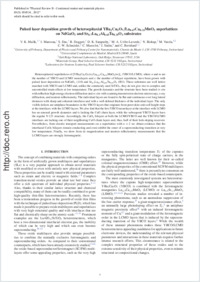Pulsed laser deposition growth of heteroepitaxial YBa2Cu3O7/La0.67Ca0.33MnO3 superlattices on NdGaO3 and Sr0.7La0.3Al0.65Ta0.35O3 substrates
- Malik, Vivek Kumar University of Fribourg, Department of Physics and Fribourg Centre for Nanomaterials, Switzerland - Department of Chemical Engineering and Material Science, University of California, Davis, USA
- Marozau, I. University of Fribourg, Department of Physics and Fribourg Centre for Nanomaterials, Switzerland
- Das, Saikat University of Fribourg, Department of Physics and Fribourg Centre for Nanomaterials, Switzerland
- Doggett, B. University of Fribourg, Department of Physics and Fribourg Centre for Nanomaterials, Switzerland
- Satapathy, Dillip Kumar University of Fribourg, Department of Physics and Fribourg Centre for Nanomaterials, Switzerland
- Uribe-Laverde, Miguel Angel University of Fribourg, Department of Physics and Fribourg Centre for Nanomaterials, Switzerland
- Biskup, N. Universidad Complutense de Madrid, Spain
- Varela, M. Oak Ridge National Laboratory, Oak Ridge, USA - Universidad Complutense de Madrid, Spain
- Schneider, C. W. Materials Group, Paul Scherrer Institut, Villigen, Switzerland
- Marcelot, C. Laboratory for Neutron Scattering, Paul Scherrer Institut, Switzerland
- Stahn, J. Laboratory for Neutron Scattering, Paul Scherrer Institut, Switzerland
- Bernhard, Christian University of Fribourg, Department of Physics and Fribourg Centre for Nanomaterials, Switzerland
-
27.02.2012
Published in:
- Physical Review B - Condensed matter and materials physics. - 2012, vol. 85, no. 5, p. 054514
English
Heteroepitaxial superlattices of [YBa₂Cu₃O₇(n)/La0.67Ca0.33MnO₃(m)]x (YBCO/LCMO), where n and m are the number of YBCO and LCMO monolayers and x the number of bilayer repetitions, have been grown with pulsed laser deposition on NdGaO₃ (110) and Sr0.7La0.3Al0.65Ta0.35O₃ (001). These substrates are well lattice matched with YBCO and LCMO and, unlike the commonly used SrTiO₃, they do not give rise to complex and uncontrolled strain effects at low temperature. The growth dynamics and the structure have been studied in situ with reflection high-energy electron diffraction and ex situ with scanning transmission electron microscopy, x-ray diffraction, and neutron reflectometry. The individual layers are found to be flat and continuous over long lateral distances with sharp and coherent interfaces and with a well-defined thickness of the individual layer. The only visible defects are antiphase boundaries in the YBCO layers that originate from perovskite unit-cell height steps at the interfaces with the LCMO layers. We also find that the first YBCO monolayer at the interface with LCMO has an unusual growth dynamics and is lacking the CuO chain layer, while the subsequent YBCO layers have the regular Y-123 structure. Accordingly, the CuO₂ bilayers at both the LCMO/YBCO and the YBCO/LCMO interfaces are lacking one of their neighboring CuO chain layers and, thus, half of their hole-doping reservoir. Nevertheless, from electric transport measurements on a superlattice with n=2 we obtain evidence that the interfacial CuO₂ bilayers remain conducting and even exhibit the onset of a superconducting transition at very low temperature. Finally, we show from dc magnetization and neutron reflectometry measurements that the LCMO layers are strongly ferromagnetic.
- Faculty
- Faculté des sciences et de médecine
- Department
- Département de Physique
- Language
-
- English
- Classification
- Physics
- License
- License undefined
- Identifiers
-
- RERO DOC 29166
- DOI 10.1103/PhysRevB.85.054514
- Persistent URL
- https://folia.unifr.ch/unifr/documents/302493
Statistics
Document views: 72
File downloads:
- ber_pld.pdf: 162
